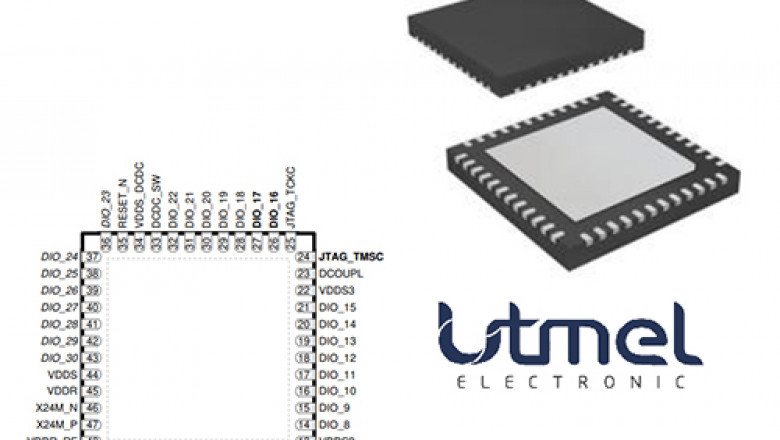views

CC2640R2F VS. CC2640R2L
CC2640R2FRGZR Description
The CC2640R2FRGZR is a 2.4 GHz wireless microcontroller (MCU) that supports Bluetooth® 5.1 Low Energy as well as proprietary 2.4 GHz applications. The gadget is designed for low-power wireless communication and enhanced sensing in building security systems, HVAC, asset tracking, and medical industries, as well as applications requiring industrial performance.
CC2640R2FRGZR Pinout

CC2640R2FRGZR CAD Model
Symbol

Footprint

3D Model

CC2640R2FRGZR Features
• Microcontroller
– Powerful Arm® Cortex®-M3
– EEMBC CoreMark® score: 142
– Up to 48-MHz clock speed
– 275KB of nonvolatile memory including 128KB
of in-system Programmable Flash
– Up to 28KB of system SRAM, of which 20KB is
ultra-low leakage SRAM
– 8KB of SRAM for cache or system RAM use
– 2-Pin cJTAG and JTAG debugging
– Supports over-the-air upgrade (OTA)
• Ultra-low power sensor controller
– Can run autonomous from the rest of the
system
– 16-bit architecture
– 2KB of ultra-low leakage SRAM for code and
data
• Efficient code size architecture, placing drivers,
TI-RTOS, and Bluetooth® software in ROM to
make more Flash available for the application
• RoHS-compliant packages
– 2.7-mm × 2.7-mm YFV DSBGA34 (14 GPIOs)
– 4-mm × 4-mm RSM VQFN32 (10 GPIOs)
– 5-mm × 5-mm RHB VQFN32 (15 GPIOs)
– 7-mm × 7-mm RGZ VQFN48 (31 GPIOs)
• Peripherals
– All digital peripheral pins can be routed to any
GPIO
– Four general-purpose timer modules
(eight 16-bit or four 32-bit timers, PWM each)
– 12-bit ADC, 200-ksamples/s, 8-channel analog
MUX
– Continuous time comparator
– Ultra-low power analog comparator
– Programmable current source
– UART, I2C, and I2S
– 2× SSI (SPI, MICROWIRE, TI)
– Real-Time Clock (RTC)
– AES-128 security module
– True Random Number Generator (TRNG)
– Support for eight capacitive-sensing buttons
– Integrated temperature sensor
• External system
– On-chip internal DC/DC converter
– Seamless integration with CC2590 and
CC2592 range extenders
– Very few external components
– Pin compatible with the SimpleLink™ CC2640
and CC2650 devices in all VQFN packages
– Pin compatible with the SimpleLink™ CC2642R
and CC2652R devices in 7-mm x 7-mm VQFN
packages
– Pin compatible with the SimpleLink™ CC1350
device in 4-mm × 4-mm and 5-mm × 5-mm
VQFN packages
• Low power
– Wide supply voltage range
• Normal operation: 1.8 to 3.8 V
• External regulator mode: 1.7 to 1.95 V
– Active-Mode RX: 5.9 mA
– Active-Mode TX at 0 dBm: 6.1 mA
– Active-Mode TX at +5 dBm: 9.1 mA
– Active-Mode MCU: 61 µA/MHz
– Active-Mode MCU: 48.5 CoreMark/mA
– Active-Mode sensor controller:
0.4mA + 8.2 µA/MHz
– Standby: 1.1 µA (RTC running and RAM/CPU
retention)
– Shutdown: 100 nA (wake up on external
events)
• RF section
– 2.4-GHz RF transceiver compatible with
Bluetooth® Low Energy 5.1 and earlier LE
specifications
– Excellent receiver sensitivity (–97 dBm for
BLE), selectivity, and blocking performance
– Link budget of 102 dB for BLE
– Programmable output power up to +5 dBm
– Single-ended or differential RF interface
– Suitable for systems targeting compliance with
worldwide radio frequency regulations
• ETSI EN 300 328 (Europe)
• EN 300 440 Class 2 (Europe)
• FCC CFR47 Part 15 (US)
• ARIB STD-T66 (Japan)
• Development Tools and Software
– Full-feature development kits
– Multiple reference designs
– SmartRF™ Studio
– Sensor Controller Studio
– IAR Embedded Workbench® for Arm®
– Code Composer Studio™ Integrated
Development Environment (IDE)
– Code Composer Studio™ Cloud IDE
CC2640R2FRGZR Functional Block Diagram

CC2640R2FRGZR Recommended Operating Conditions
| MIN | MAX | UNIT | |||
| Ambient temperature | -40 | 85 | °C | ||
| Operating supply voltage (VDDS and VDDR). external regulator mode | For operation in 1.8-V systems (VDDS and VDDR pins connected on PCB. internal DC/DC cannot be used) | 1.7 | 1.95 | V | |
| Operating supply voltage VDDS | 1.8 | 3.8 | V | ||
| Operating supply voltages VDDS2 and VDDS3 | For operation in battery-powered and 3.3-V systems (internal DC/DC can be used to minimize power consumption) | VDDS v 2.7 V | 1.8 | 3.8 | V |
| Operating supply voltages VDDS2 and VDDS3 | VDDS 2 2.7 V | 1.9 | 3.8 | V | |
CC2640R2FRGZR Advantages
• Support for Bluetooth ® 5.1 technologies such as LE Coded PHYs (Long Range), LE 2-Mbit PHY (High Speed), Advertising Extensions, Multiple Advertisement Sets, as well as backwards compatibility and support for important Bluetooth ® 5.0 and older Low Energy requirements.
• The SimpleLinkTM CC2640R2F Software Development Kit (SDK) includes a fully approved Bluetooth ® 5.1 software protocol stack for developing applications on the powerful Arm® Cortex®-M3 processor.
• Wireless applications with a lower standby current of 1.1 A and full RAM retention have a longer battery life.
• Advanced sensing using a configurable, self-contained ultra-low power Sensor Controller CPU with quick wakeup capability. The sensor controller, for example, is capable of 1-Hz ADC sampling at 1 A system current.
• Dedicated software-controlled radio controller (Arm® Cortex®-M0) with low-power RF transceiver capability to support numerous physical layers and RF standards, such as real-time localization (RTLS) technologies.
• Bluetooth ® Low Energy has excellent radio sensitivity and robustness (selectivity and blocking) performance (-103 dBm for 125-kbps LE Coded PHY).
CC2640R2FRGZR Equivalents
| Part Number | Description | Manufacturer |
| CC2640R2FRSMTTELECOMMUNICATION CIRCUITS | SimpleLink™ 32-bit Arm® Cortex®-M3 Bluetooth® 5.1 Low Energy wireless MCU with 128-kB flash 32-VQFN -40 to 85 | Texas Instruments |
| XCC2640R2FTWRGZTQ1TELECOMMUNICATION CIRCUITS | Automotive Qualified SimpleLink™ Bluetooth® low energy Wireless MCU 48-VQFN -40 to 105 | Texas Instruments |
| CC2640R2FTWRGZRQ1TELECOMMUNICATION CIRCUITS | SimpleLink™ automotive qualified 32-bit Arm Cortex-M3 Bluetooth® Low Energy wireless MCU 48-VQFN -40 to 105 | Texas Instruments |
| CC2640R2FRHBTTELECOMMUNICATION CIRCUITS | SimpleLink™ 32-bit Arm® Cortex®-M3 Bluetooth® 5.1 Low Energy wireless MCU with 128-kB flash 32-VQFN -40 to 85 | Texas Instruments |
| CC2640R2FTWRGZQ1TELECOMMUNICATION CIRCUITS | Telecom Circuit | Texas Instruments |
| CC2640R2FYFVTTELECOMMUNICATION CIRCUITS | SimpleLink™ 32-bit Arm® Cortex®-M3 Bluetooth® 5.1 Low Energy wireless MCU with 128-kB flash 34-DSBGA -40 to 85 | Texas Instruments |
CC2640R2FRGZR Applications
• Home and Building Automation
– Connected appliances
– Lighting
– Smart locks
– Gateways
– Security Systems
• Industrial
– Factory automation
– Asset tracking and management
– HMI
– Access control
• Electronic Point Of Sale (EPOS)
– Electronic Shelf Label (ESL)
• Health and Medical
– Electronic thermometers
– SpO2
– Blood glucose monitors and blood pressure monitors
– Weigh scales
– Hearing aids
• Sports and Fitness
– Wearable fitness and activity monitors
– Smart trackers
– Patient monitors
– Fitness machines
• HID
– Gaming
– Pointing devices (wireless keyboard and mouse)
CC2640R2F VS. CC2640R2L
The two microcontrollers both use a single-cor software development kit (SDK). They are low-power wireless microcontrollers, and can transmit and receive radio frequency signals at a greater distance.
The two devices have lots in common, but they are different in some aspects. For instance, CC2640R2F supports BLE 5.0 protocol, while CC2640R2L supports BLE 5.1 protocol. CC2640R2L doesn’t have a sensor controller engine, which makes it cheaper than CC2640R2F but more suitable in the basic transparent transmission application. From that, we can say that CC2640R2L is a lower-cost version of CC2640R2F.
CC2640R2FRGZR Manufacturer
Texas Instruments Incorporated (TI) is an American technology company based in Dallas, Texas, that designs and manufactures semiconductors and various integrated circuits, which it sells to electronics designers and manufacturers globally. It is one of the top 10 semiconductor companies worldwide based on sales volume. The company's focus is on developing analog chips and embedded processors, which account for more than 80% of its revenue. TI also produces TI digital light processing technology and education technology products including calculators, micro-controllers, and multi-core processors. The company boasts 45,000 patents around the globe as of 2016.












